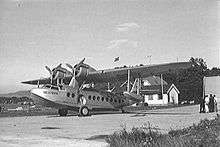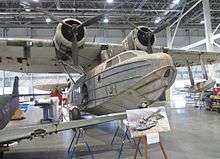Sikorsky S-43
The Sikorsky S-43 Baby Clipper was a twin-engine amphibious aircraft manufactured in United States during the 1930s by the American firm Sikorsky Aircraft.
| S-43 (JRS-1) | |
|---|---|
.jpg) | |
| U.S. Navy Sikorsky JRS-1 in 1945 | |
| Role | Flying boat airliner |
| National origin | United States |
| Manufacturer | Sikorsky Aircraft |
| Designer | Igor Sikorsky |
| First flight | 1935 |
| Introduction | 1934 |
| Primary users | Pan American Airways Hawaiian Airlines |
| Number built | 53 |
Design and development
.jpg)
The S-43 first flew in 1935, and was a smaller version of the Sikorsky S-42 "Clipper". It accommodated between 18 and 25 passengers, with a separate two-crew forward cockpit.[1] The S-43 was known as the "Baby Clipper" in airline service.
On April 14, 1936, an S-43 with a 500 kilograms (1,100 lb) payload, piloted by Boris Sergievsky, set an altitude record for amphibious aircraft when it reached an altitude of 27,950 feet above Stamford, Connecticut. Also aboard was designer Igor Sikorsky.[2]
In total, approximately 53 S-43s were built, including examples of the twin-tailed S-43B.[3]
Operational history

_Pima_10.05R.jpg)

_on_exhibit_in_the_main_hall_of_the_Smithsonian's_Udvar-Hazy_Center.jpg)
The S-43 was used primarily by Pan American World Airways for flights to Cuba and within Latin America. Inter-Island Airways of Hawaii (Inter-Island changed its name to Hawaiian Airlines in 1941) was the launch customer for the S-43.[4] Inter-Island operated four S-43's to ferry Pan Am Clipper passengers and local residents from Honolulu throughout the Hawaiian Islands. Inter-Island sold its only twin-tail version to KLM.[4] One aircraft was purchased by Norwegian airline Det Norske Luftfartselskap. Panair do Brasil operated seven aircraft. Five S-43s were used between 1937 and 1945 by the French company Aéromaritime on a colonial airway between Dakar (Senegal) and Pointe-Noire (Congo).[5] Reeve Aleutian Airways owned two S-43s during the 1950s, one operational (N53294 purchased 1948 and trade for G-21 in 1957) and one for spares (fuselage at Alaska Aviation Heritage Museum). Another S-43 was operated in Alaska with an unknown operator, wrecked at Chignik, AK, 1950s.[6]
Five aircraft were acquired by the U.S. Army Air Corps in 1937 under the designation OA-8 and were used for transport of freight and passengers.[7] 17 aircraft were procured by the U.S. Navy between 1937 and 1939 as the JRS-1, two of which served the U.S. Marine Corps. One JRS survived in service at the end of 1941.[8]
The Smithsonian National Air & Space Museum's Steven F. Udvar-Hazy Center in Virginia has now put a Sikorsky JRS-1 on display. This aircraft was on duty at Pearl Harbor on December 7th, 1941.[9]
Two aircraft went to private owners: Harold Vanderbilt and Howard Hughes. Hughes' S-43 N440 remains the last example of this aircraft type flying . It is now owned by Kermit Weeks and has been relocated from Texas to the restoration facility at the Fantasy of Flight Museum in Polk City, Florida where it is awaiting reassembly and restoration.
The Chilean Air Force (FACH) (formerly known as Fuerza Aérea Nacional (FAN)) in 1936 bought 2 S-43: No. 1 named "Magallanes" and the No.2 named "Chiloé", because that aircraft was going to use in the Línea Aérea Experimental Puerto Montt-Magallanes (Experimental Air Line from Puerto Montt to Magallanes) flying through the Patagonian fjords. [10]
Accidents and incidents
- June 2, 1937
- The Chilean Air Force S-43 (No. 2) capsized off Ancud, Chile, killing all nine on board.[11]
- August 2, 1937
- A Pan American-Grace Airways (Panagra) S-43B (NC15065) crashed in the vicinity of Coco Solo in the Panama Canal Zone; all 14 on board died. The plane spiraled into the water at approximately 90 mph and was destroyed by an immediate explosion and fire. Most probable cause of the crash was failure of one or both of the engines due to a faulty gasoline system and/or sudden and severe rain, as the pilot indicated losing altitude two times in the three minutes prior to the crash.[12]
- August 8, 1937
- A China National Aviation Corporation (CNAC) S-43W (named Chekiang) ditched at Chilang Point, Bias Bay, China, killing three of four crew; all seven passengers survived. The flying boat was forced to ditch due to bad weather. High waves broke one wing off; the eight survivors clung to the other wing until rescued.[13]
- April 25, 1938
- Pan Am Flight 105, an S-43B (NC16932) stalled and crashed on landing off Kingston due to engine failure; all 18 passengers and crew survived, but the aircraft was written off.[14]
- August 13, 1939
- A Pan Am S-43 (NC16933) crashed into Guanabara Bay off Rio de Janeiro due to loss of control following engine failure, killing 14 of 16 on board.
- May 17, 1943
- Hughes crashed his S-43 into Lake Mead, killing CAA inspector Ceco Cline and Hughes employee Richard Felt. The aircraft was later raised and restored to flying condition.
- August 3, 1945
- Pan Am Flight 216, an S-43 (NC15066), crashed on landing at Fort de France Hydrobase due to weather and pilot error, killing four of 14 on board.[15]
- January 3, 1947
- A Panair do Brasil S-43B (PP-PBN) crashed in the Amazon River at São Paulo de Olivenca, killing 11 of 14 on board.[16]
Specifications (S-43)
Data from [17], American flying boats and amphibious aircraft : an illustrated history[18]
General characteristics
- Crew: 2
- Capacity: 19 pax
- Length: 51 ft 2 in (15.60 m)
- Wingspan: 86 ft 0 in (26.21 m)
- Height: 17 ft 8 in (5.38 m)
- Wing area: 780.6 sq ft (72.52 m2)
- Airfoil: root: NACA 2218; tip: NACA 2212[19]
- Empty weight: 12,750 lb (5,783 kg)
- Gross weight: 19,500 lb (8,845 kg)
- Fuel capacity: 100 US gal (83 imp gal; 380 l) in four wing tanks
- Powerplant: 2 × Pratt & Whitney R-1690-52 Hornet 9-cylinder air-cooled radial piston engines, 750 hp (560 kW) each at 7,000 ft (2,100 m)
- Propellers: 3-bladed Hamilton Standard variable-pitch propellers
Performance
- Maximum speed: 178 mph (286 km/h, 155 kn) at sea level
- 190 mph (170 kn; 310 km/h) at 7,000 ft (2,100 m)
- Cruise speed: 166 mph (267 km/h, 144 kn) at 7,000 ft (2,100 m)
- Alighting speed: 64 mph (56 kn; 103 km/h)
- Range: 775 mi (1,247 km, 673 nmi) at 7,000 ft (2,100 m) at 70% power
- Service ceiling: 19,000 ft (5,800 m)
- Rate of climb: 1,000 ft/min (5.1 m/s)
- Wing loading: 25 lb/sq ft (120 kg/m2)
- Power/mass: 13 lb/hp (7.9 kg/kW)
References
- Notes
- Simpson, 2001, p. 499
- Special to the New York Times. "Sikorsky Amphibian Climbs to 27,950 Feet; Two World Altitude Records Are Claimed", The New York Times. April 15, 1936. Page 1.
- Simpson, 2001, p. 499
- Thiele, Ray (1994). Kennedy's Hawaiian Air. Olomana Publishers. p. 41,60. ISBN 0-9643365-0-2.
- "HISTOIRE DE L' "AÉROMARITIME" - Air France - une Histoire d'Amour" (in French). 2008-06-21. Retrieved 2016-06-25.
- Flying Beats Work by Cohen
- Swanborough, 1963, p. 528
- Swanborough, 1990, p. 524
- "Sikorsky JRS-1."Smithsonian National Air and Space Museum. Retrieved: 15 June 2013.
- Rodríguez, José Nicolás. "80 años del arribo de los Sikorsky S-43 a la Fuerza Aérea Nacional". tallyho.cl. Retrieved 16 June 2020.
- Accident description for No.2 at the Aviation Safety Network. Retrieved on 2014-6-24.
- Accident description for NC15065 at the Aviation Safety Network. Retrieved on 2014-6-24.
- Accident description at the Aviation Safety Network. Retrieved on 2014-6-24.
- Accident description for NC16932 at the Aviation Safety Network. Retrieved on 2012-6-24.
- Accident description for NC15066 at the Aviation Safety Network. Retrieved on 2012-6-24.
- Accident description for PP-PBN at the Aviation Safety Network. Retrieved on 24 June 2014.
- Grey, C.G.; Bridgman, Leonard, eds. (1938). Jane's all the World's Aircraft 1938. London: Sampson Low, Marston & company, ltd. p. 297c.
- Johnson, E.R. (2009). American flying boats and amphibious aircraft : an illustrated history. Jefferson, N.C.: McFarland & Co. pp. 200–202. ISBN 978-0786439744.
- Lednicer, David. "The Incomplete Guide to Airfoil Usage". m-selig.ae.illinois.edu. Retrieved 16 April 2019.
- Bibliography
- Simpson, Rod (2001). Airlife's World Aircraft. Airlife Publishing Ltd. ISBN 1-84037-115-3.
- Swanborough, Gordon (1963). United States Military Aircraft since 1909. Putnam & Co. Ltd.
- Swanborough, Gordon (1990). United States Navy Aircraft since 1911. Putnam Aeronautical Press. ISBN 0-87021-792-5.
External links
| Wikimedia Commons has media related to Sikorsky S-43. |
- Video - Howard Hughes Sikorsky S-43